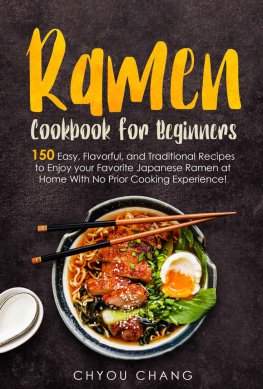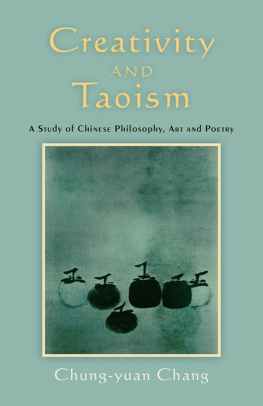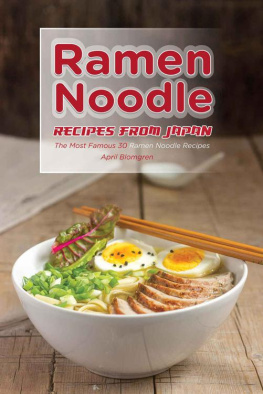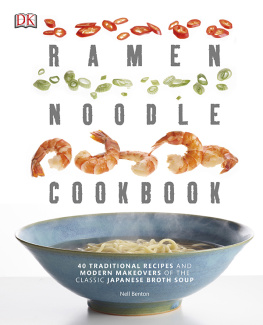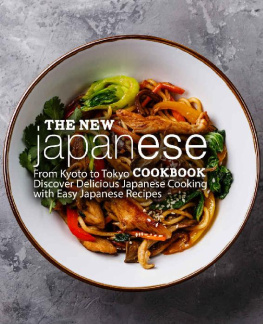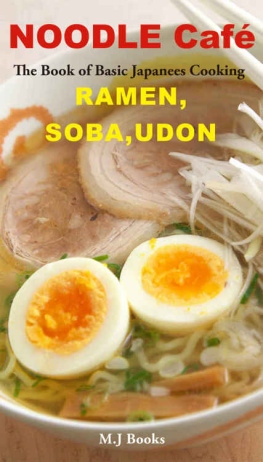Ramen Cookbook for Beginners 150 Easy, Flavorful, and Traditional Recipes to Enjoy Japanese Ramen at Your Own Home Kitchen Without Prior Cooking Experience! Table of Contents
INTRODUCTION
Food is an essential part of our life. And what better staple can one take as a meal at least once daily than Ramen? Yes, this food needs no introduction because it is one of the most popular staple foods in the world today. If you have only heard of it but never got to experience it, then this is just the right place to start! Ramen is a noodle soup that originated from Yokohama, Japan. Evidence of its popularity is seen in the fact that almost all the regions in the country have its variation of Ramen. This also shows the possibility of the food to be adapted to almost limitless recipes at the whims of just about any cook, amateur or professional. Perhaps that is the reason for its acceptance in many other countries across the world.
In Korea, it is known as Ramyeon, while Taiwanese have tagged it Rishi Lamian. Many restaurants in the United States of America, the UK, other top vacation destinations serve varieties of Ramen Noodles Soup. What makes Ramen even more endearing is the fact that anyone can cook it. As long as you have a good kitchen, a knack for culinary adventure, and a long list of Ramen recipes, you are good to go. So, you don't need a restaurant for the food. All you have to do is run through this book for any recipe that grabs your fancy.
You have got a delightful list of 150 recipes that are flavorful, easy-to-prepare, and enjoyable. Each recipe is placed under a broad heading just so you can decide on what to prepare more easily without having to do more than scan the book. Let's face it. This cookbook is just the right addition to your kitchen. Another good news is that you may choose a recipe based on what you have in your pantry.
Get Your Kitchen Ready
Cooking is never done in a vacuum! So, having the appropriate kitchen in place is crucial to making all the recipes in this book.
Get Your Kitchen Ready
Cooking is never done in a vacuum! So, having the appropriate kitchen in place is crucial to making all the recipes in this book.
You are never getting anywhere in your culinary adventures without a proper kitchen, from cookware to ovens and the necessary paraphernalia. And surely, you want to get the best experience making your ramen noodles recipes. The reason for this is not far-fetched. Many of the recipes in this book could be new to you. To get them right is not down to the clear instructions alone. You also need a good kitchen to make your preparations and cooking smooth.
And of course, you need to get it ready. So, what are the exact necessities you need in place?
Bowls
These are necessary for preparation and serving. Having a lot of plates and bowls to hold prepared ingredients for your ramen makes for efficiency, precision, and good, tasty outcomes. Apart from holding the prepared ingredients, you could need to reserve per-boiled liquid mixtures. It must be emphasized that you need mixing bowls, especially the 2.5l mixing bowls for larger ingredients and 1l mixing bowl for smaller ingredients and spices.
Chefs Knife
Your kitchen must have a handy chefs knife in place.
This piece of utensil normally has a 20-30.5cm or 8-12-inch blade but comes in various weights and sizes. Because of the multiple tasks required to prepare certain ramen recipes, ensure you have one with a handle that makes cutting and chopping comfortable activities.
Chopping Boards
Ramen cuisines require a lot of chopping and cutting. Since you will be dealing with meats and vegetables, get ready to have a plastic chopping board for the former and the wooden version for the latter. These essential utensils come in various sizes and shapes, from which you can select your perfect choice.
Paring Knife
You will need this knife with a narrow-edged blade for skinning, peeling, deveining your ingredients.
When it comes to ramen dishes, you never know how delicate the instructions could get.
Lidded Stockpot
The idea stockpot to have in place is an 11.5l (or something slightly larger) pot. It will come in handy for making good ramen stock. Be sure to have one that comes with a heavy lid.
Braising Dish
Braising is a cooking method that requires the use of both dry and wet heat. Sometimes, you need this method for certain aspects of some ramen dishes.
As such, you could need braising dishes. The size would depend on the recipes you intend to make.
Pots and Pans
Now, these are essential for most ramen foods. It doesnt matter whether they have lids or not. You can use foil as an alternative.
Noodle Basket
Well, the main staple in these scores of recipes is noodles.
Noodle Basket
Well, the main staple in these scores of recipes is noodles.
The need for a noodle basket cannot be overemphasized. It will help you to strain and cook noodles. You can also use it to blanch small batches of vegetables.
Rolling Pin
A rolling pin is also of the essence when it comes to making noodles. It is used for rolling out noodle dough and comes in a variety of sizes and shapes.
Pasta Roller and Cutter
You could need a pasta roller and cutter to roll out and portion the dough for noodles.
Pasta Roller and Cutter
You could need a pasta roller and cutter to roll out and portion the dough for noodles.
This is essential to have ready in your kitchen just so you can explore any kind of ramen recipe.
Skimmer
When scum comes to the surface of a simmering broth, you need them skimmed. This is what a skimmer is designed for. Since broth is a major component of most ramen cuisines, it is a kitchen essential you need handy.
Fine-Mesh Strainer
For efficient skimming, fine-mesh skimmers are recommended. The same can be said for straining.
With a fine-mesh strainer, you will effectively pour the liquid through to separate unwanted small bits.
Colander
A durable colander is required as well. It is used to rinse and clean the bones in ramen stocks. Most colanders have larger holes than strainers, which allows the remains from bones to be easily separated. Ladle
Ladle
A Stainless-steel ladle, which is durable and ideal for long-term use, is recommended. You are going to need it for portioning your broth to circumvent tilting a large pot.
This is one of the things that will help reduce stress while cooking your ramen.
Slotted Spoon
Speaking of ease while cooking ramen, slotted is yet another poster child. The utensil has slots in its wide part, which makes liquid go through the food item. As such, you will find it handy if you need to fish out ingredients.
Tongs
You may need tongs to grasp ingredients (especially seafood and meat) for frying, sauting, and grilling. They are also used for breaking up and portioning noodles.
A few others To get started and complete making a delicious ramen meal, you need more than the above-listed items. A few other items needed include immersion blender, pressure cooker, renge (ramen spoon), chop sticks, egg timer, and ramen spork.
Basic Ramen Components
This book has good scores of ramen recipes. Almost every one of them has got broth, noodles, seasoning, and toppingsoften described as the components of a traditional ramen meal. Before diving into the sea of ramen recipes here, you could use a little introduction to each component.
Broth
This is the soup base without which a ramen meal is incomplete.
It could take either the Paitan or Chintan form. While some intricate soups are variations of the two combined, either the Paitan (light-colored) or Chintan (opaque-colored) forms the soup base of ramen foods. Dont worry. You should be quite familiar with a couple of illustrations. The classic shoyu, which is the Japanese ramen made with soy sauce and pork bone broth, are popular examples of Chintan or Paitan, respectively.

